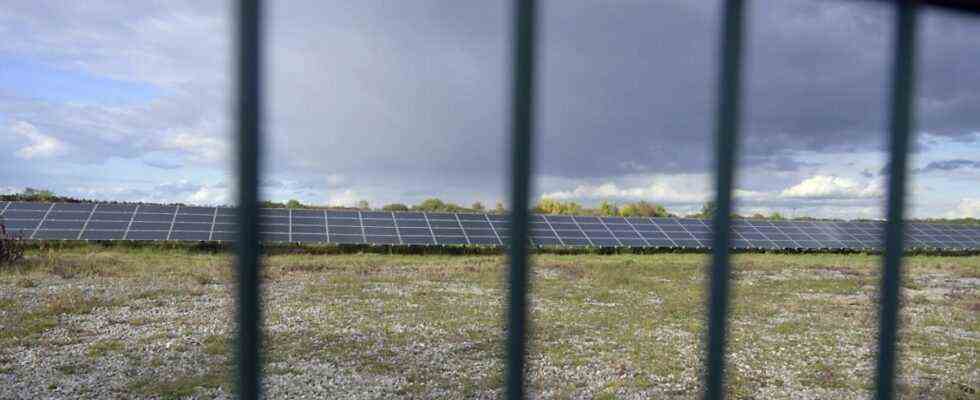At the turn of the millennium he was one of the pioneers and soon also one of the greats in the solar industry. But then the market collapsed. And Klaus Gehrlicher went into bankruptcy with his company, which in the meantime made billions in sales. To this day, he is reluctant to talk about the reasons for the, in his view, no fault and in any case painful collapse. But all the better about the industry, which today is seen by many as a great beacon of hope in the fight against climate change. Gehrlicher is still fully involved. Specifically, he wants to give new power to what was once the largest open-space photovoltaic system in the district, which he built in Haar.
Decades ago it was clear to some that climate change is forcing action. In the meantime, there is extensive discussion at many levels about how the consequences of global warming can still be brought under control. In Garching, new open-space systems are currently on the agenda (), as is the case in Hohenbrunn and Putzbrunn. Member of the Bundestag Florian Hahn and Kirchheim’s Mayor Maximilian Böltl (both CSU) toasted Berlin to have it checked whether and how areas on motorways could be used for solar energy. And not only Klaus Gehrlicher, who lives in hair, observes that many are now talking about things that he preached decades ago.
At the end of 2007, the open space system in the Salmdorf district of Haar with a capacity of over one megawatt went online as a public solar project initiated by Gehrlicher and was widely praised. To date, it has produced around 1000 megawatt hours of electricity and mathematically covers the needs of around 1000 hair people.
Gehrlicher would now like to more than double the yield with more powerful modules and also set up a demonstration system for agri-photovoltaics in Salmdorf, which shows that agriculture and solar use are not mutually exclusive in one area. “This is not the work of the devil,” says Gehrlicher. Everything is still going “incredibly slowly”, he complains and for a moment on the phone he sounds as impatient as one imagines the man who headed Gehrlicher Solar AG in 2010, which was one of the “Technology Fast 50” companies in Germany and was one of the fastest growing companies in the republic.
Since 2007, solar power production has grown steadily in Haar and in the district, but not rapidly. Six more open-space systems were added, according to figures from the district office, the largest of them in Garching with a peak output of 2.5 megawatts. From 2016 to 2018, according to the latest available data, the installed capacity of photovoltaic systems on roofs and open spaces in the district rose from 66 to 85 megawatts. An increase of 29 percent. The head of the climate initiative project 29 ++ in the district office, Philipp Schramek, wants to see more dynamism soon. He takes care of strategically advancing the conversion to renewable energies in the district. A reduction in CO₂ emissions to six tons per district citizen is targeted by 2030. But that is not an end point. “We will need even more ambitious goals,” says Schramek. He has therefore initiated a process to give the municipalities a stronger role as actors at the grassroots level.
A major factor in the district is said to be photovoltaics. The energy agency Ebersberg-Munich is promoting so-called bundle campaigns to help as many citizens as possible with good advice to screw modules onto their roofs. An action is currently running in Höhenkirchen-Siegertsbrunn. Brunnthal will follow in November. There is great interest, says energy consultant Tobias Sassmann. In some municipalities there are waiting lists. Bürgerenergie Unterhaching (BEU) is ambitious in creating citizen solar systems. They started in 2012. Today the BEU has two open space systems on the A 8 near Unterhaching and Ottobrunn as well as 14 roof systems. There are also some projects that CEO Wolfgang Geisinger would like to tackle. But like the entrepreneur Gehrlicher, Geisinger has experienced that there are high hurdles to overcome for large solar projects, especially in the Munich metropolitan area.
So land is scarce. Owners thought long and hard about the increases in value, says Geisinger, as to whether they would lease space for 20 or 25 years. Planning processes are also complex. Building authorities are burdened with many projects and have a small staff. The BEU supports the authorities as best it can with external planners. Gehrlicher is already talking about his repowering plans, which he wants to implement in 2027, not least because of the well-known long lead times for many projects. Recently, Mayor Andreas Bukowski and local councilors in Salmdorf had the project shown at the facility, which is located on community property.

